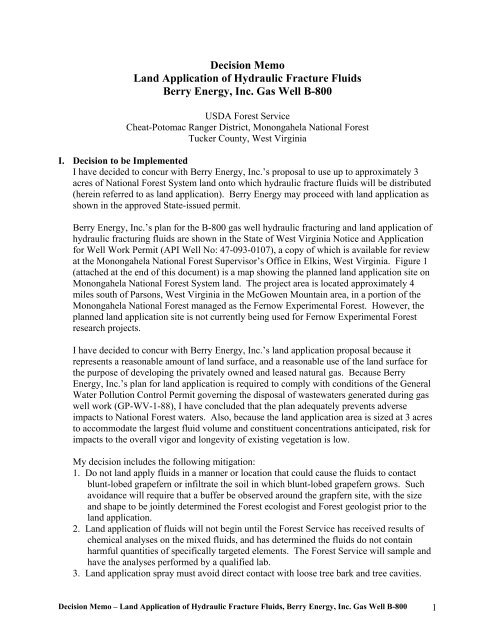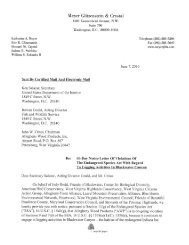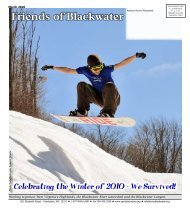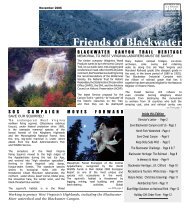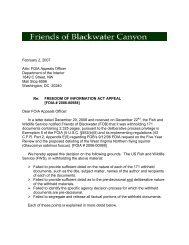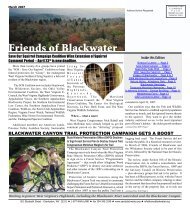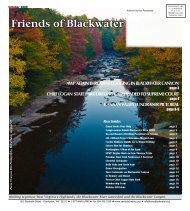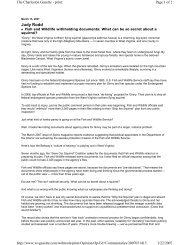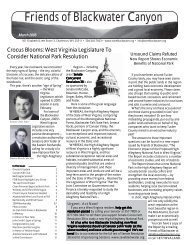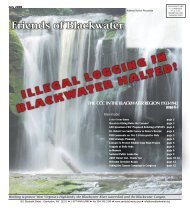Decision Memo from USFS
Decision Memo from USFS
Decision Memo from USFS
You also want an ePaper? Increase the reach of your titles
YUMPU automatically turns print PDFs into web optimized ePapers that Google loves.
<strong>Decision</strong> <strong>Memo</strong><br />
Land Application of Hydraulic Fracture Fluids<br />
Berry Energy, Inc. Gas Well B-800<br />
USDA Forest Service<br />
Cheat-Potomac Ranger District, Monongahela National Forest<br />
Tucker County, West Virginia<br />
I. <strong>Decision</strong> to be Implemented<br />
I have decided to concur with Berry Energy, Inc.’s proposal to use up to approximately 3<br />
acres of National Forest System land onto which hydraulic fracture fluids will be distributed<br />
(herein referred to as land application). Berry Energy may proceed with land application as<br />
shown in the approved State-issued permit.<br />
Berry Energy, Inc.’s plan for the B-800 gas well hydraulic fracturing and land application of<br />
hydraulic fracturing fluids are shown in the State of West Virginia Notice and Application<br />
for Well Work Permit (API Well No: 47-093-0107), a copy of which is available for review<br />
at the Monongahela National Forest Supervisor’s Office in Elkins, West Virginia. Figure 1<br />
(attached at the end of this document) is a map showing the planned land application site on<br />
Monongahela National Forest System land. The project area is located approximately 4<br />
miles south of Parsons, West Virginia in the McGowen Mountain area, in a portion of the<br />
Monongahela National Forest managed as the Fernow Experimental Forest. However, the<br />
planned land application site is not currently being used for Fernow Experimental Forest<br />
research projects.<br />
I have decided to concur with Berry Energy, Inc.’s land application proposal because it<br />
represents a reasonable amount of land surface, and a reasonable use of the land surface for<br />
the purpose of developing the privately owned and leased natural gas. Because Berry<br />
Energy, Inc.’s plan for land application is required to comply with conditions of the General<br />
Water Pollution Control Permit governing the disposal of wastewaters generated during gas<br />
well work (GP-WV-1-88), I have concluded that the plan adequately prevents adverse<br />
impacts to National Forest waters. Also, because the land application area is sized at 3 acres<br />
to accommodate the largest fluid volume and constituent concentrations anticipated, risk for<br />
impacts to the overall vigor and longevity of existing vegetation is low.<br />
My decision includes the following mitigation:<br />
1. Do not land apply fluids in a manner or location that could cause the fluids to contact<br />
blunt-lobed grapefern or infiltrate the soil in which blunt-lobed grapefern grows. Such<br />
avoidance will require that a buffer be observed around the grapfern site, with the size<br />
and shape to be jointly determined the Forest ecologist and Forest geologist prior to the<br />
land application.<br />
2. Land application of fluids will not begin until the Forest Service has received results of<br />
chemical analyses on the mixed fluids, and has determined the fluids do not contain<br />
harmful quantities of specifically targeted elements. The Forest Service will sample and<br />
have the analyses performed by a qualified lab.<br />
3. Land application spray must avoid direct contact with loose tree bark and tree cavities.<br />
<strong>Decision</strong> <strong>Memo</strong> – Land Application of Hydraulic Fracture Fluids, Berry Energy, Inc. Gas Well B-800 1
A. Description of the Proposed Activities<br />
Gas Well Site and Access Road<br />
Berry Energy, Inc. plans to conduct hydraulic fracturing of an additional potential gas<br />
horizon (called the Sycamore Grit) within the existing B-800 well that was drilled in 2008.<br />
Hydraulic fracture fluids that flow back <strong>from</strong> the well will be contained in closed tanks on<br />
the B-800 well site. After treatment of the fluids, Berry Energy proposes to discharge the<br />
fluids by dispersing them onto the land as specified in the General Water Pollution Control<br />
Permit (GP-WV-1-88) for the direct disposal of treated wastewaters generated during oil and<br />
gas well work. In addition, the proposed land application area has been sized at 3 acres to<br />
accommodate the largest fluid volume and constituent concentrations anticipated in order to<br />
minimize risk for impacts to vegetation.<br />
Berry Energy’s West Virginia well work permit, when issued by the State, will indicate<br />
compliance with State gas well permitting requirements. West Virginia Department of<br />
Environmental Protection, Office of Oil and Gas inspectors will enforce State oil and gas<br />
regulations during operations.<br />
Berry Energy plans to complete hydraulic fracturing and land application before the onset of<br />
winter weather in 2009, beginning the work as early as September 2009. Land application is<br />
likely to occur in October 2009.<br />
B. Purpose of <strong>Decision</strong><br />
As the Forest Supervisor with authority for administering mineral reservations on<br />
Monongahela National Forest System land, I received a plan <strong>from</strong> Berry Energy to land<br />
apply treated hydraulic fracture fluids on up to approximately 3 acres of Monongahela<br />
National Forest System land overlying privately owned mineral rights in which Berry Energy<br />
holds an oil and gas lease.<br />
National Forest System land on which the gas well and access road are planned is underlain<br />
by mineral rights that were reserved by the seller when the United States acquired the land in<br />
1915. This means that these mineral rights are privately owned, and the mineral owner has a<br />
right to explore for and develop their minerals. The deed for this land purchase in 1915<br />
identifies the terms of the mineral reservation that the seller and all subsequent mineral<br />
owners and their lessees are required to comply with whenever exercising their rights to<br />
explore for or develop minerals.<br />
The purpose and need for the federal action is identified by and limited to the terms of the<br />
mineral reservation. Although there are 10 terms in the mineral reservation (Department of<br />
Agriculture, General Rules and Regulations for the Mining and Removal of Minerals of<br />
1911), the mineral reservation terms pertinent to the subject federal action require the Forest<br />
Service to:<br />
1) determine that the proposal uses a reasonable amount of land surface;<br />
2) ensure that operations prevent the obstruction, pollution, or deterioration of National<br />
Forest streams, lakes, ponds or springs, and the escape of harmful or deleterious<br />
material or substances to National Forest System land <strong>from</strong> the operations; and<br />
3) verify that no vegetation is unnecessarily damaged or destroyed, including collecting<br />
payment for such damages, should they occur.<br />
<strong>Decision</strong> <strong>Memo</strong> – Land Application of Hydraulic Fracture Fluids, Berry Energy, Inc. Gas Well B-800 2
The remaining mineral reservation terms are either not pertinent to the Berry Energy<br />
proposal, such as those that apply to the conduct of underground mining, or provide no<br />
discretion as to how to meet them, such as using diligence in preventing and suppressing<br />
forest fires.<br />
In order to respond to Berry Energy’s land application proposal, as Forest Supervisor, my<br />
obligation and authority for this project was to review and determine whether or not I concur<br />
with Berry Energy’s plan to use up to approximately 3 acres of National Forest System land<br />
for land application of gas well B-800 hydraulic fracturing fluids. My authority to make this<br />
decision is derived <strong>from</strong> and limited by the above-described mineral reservation terms.<br />
II. Reasons for Categorically Excluding the <strong>Decision</strong><br />
<strong>Decision</strong>s may be categorically excluded <strong>from</strong> documentation in an environmental impact<br />
statement or an environmental assessment when they are within one of the categories<br />
identified by the Code of Federal Regulations at 36 CFR 220.6, and there are no<br />
extraordinary circumstances related to the decision that may result in a significant individual<br />
or cumulative effect on the quality of the human environment.<br />
I have concluded that this decision is appropriately categorically excluded <strong>from</strong><br />
documentation in an environmental impact statement or environmental assessment as the<br />
proposed land use is a routine activity within a category of exclusion, and there are no<br />
extraordinary circumstances related to the decision that may result in a significant individual<br />
or cumulative effect on the quality of the human environment. My conclusion is based on<br />
information presented in this document and the entirety of the Record.<br />
A.Category of Exclusion<br />
The decision fits within the category of exclusion 36 CFR 220.6(e)(3): “Approval,<br />
modification, or continuation of minor special uses of National Forest System lands that<br />
require less than five contiguous acres of land.” Although issuance of a special use<br />
permit is not required by the terms of the mineral reservation, Berry Energy, Inc.’s<br />
exercise of private mineral rights requires Forest Service concurrence with the proposed<br />
use of National Forest System land. As such, my concurrence with Berry Energy’s<br />
proposal to use up to 3 acres for land application of hydraulic fracture fluids is similar to<br />
approving the use of National Forest System land as described in category 36 CFR<br />
220.6(e)(3), absent issuing a special use permit.<br />
Berry Energy’s proposal will use up to approximately 3 acres of National Forest System<br />
land.<br />
Relationship to Extraordinary Circumstances<br />
1.Threatened and Endangered Species or Their Critical Habitat<br />
The Endangered Species Act requires that federal activities do not jeopardize the<br />
continued existence of any species federally listed or proposed as threatened or<br />
endangered, or result in adverse modification to such species’ designated critical<br />
habitat. In accordance with Section 7(c) of this Act, a list of the listed and proposed,<br />
threatened or endangered species that may be present in the project area was obtained<br />
<strong>from</strong> the U.S. Fish and Wildlife Service.<br />
<strong>Decision</strong> <strong>Memo</strong> – Land Application of Hydraulic Fracture Fluids, Berry Energy, Inc. Gas Well B-800 3
A Biological Evaluation (BE) determined that Berry Energy’s proposed activities will<br />
have no effect on any threatened, endangered species, or species proposed for listing.<br />
2.Floodplains, Wetlands, or Municipal Watersheds<br />
Floodplains: Executive Order 11988 emphasizes avoiding adverse impacts associated<br />
with the occupancy and modification of floodplains. Floodplains are defined by this<br />
order as, “…the lowland and relatively flat areas adjoining inland and coastal waters,<br />
including floodprone areas of offshore islands, including at a minimum, that area<br />
subject to a one percent [100-year recurrence] or greater chance of flooding in any one<br />
year.” The project is not located in or near floodplains. This has been validated by<br />
map and site-review. Therefore, this decision will not affect floodplains.<br />
Wetlands: Executive Order 11990 emphasizes avoiding adverse impacts associated<br />
with destruction or modification of wetlands. Wetlands are defined by this order as,<br />
“…areas inundated by surface or ground water with a frequency sufficient to support<br />
and under normal circumstances does or would support a prevalence of vegetative or<br />
aquatic life that requires saturated or seasonally saturated soil conditions for growth and<br />
reproduction. Wetlands generally include swamps, marshes, bogs, and similar areas<br />
such as sloughs, potholes, wet meadows, river overflows, mud flats, and natural<br />
ponds.” The project is not located in or near wetlands. This has been validated by map<br />
and site-review. Therefore, this decision will not affect wetlands.<br />
Municipal Watersheds: Municipal watersheds are managed under multiple use<br />
prescriptions in land and resource management plans. The Elklick Run watershed, in<br />
which Berry Energy’s operation will occur, was formerly a municipal watershed for<br />
Parsons, West Virginia. Parsons no longer uses Elklick Run for a water supply, and it<br />
is no longer a municipal watershed. Therefore, this decision will not affect any<br />
municipal watersheds.<br />
3.Congressionally Designated Areas<br />
This project is not in nor does this decision affect any Wilderness Study Areas, Wild<br />
and Scenic Rivers, or National Recreation Areas. The project area lies near the Otter<br />
Creek Wilderness, but due to the limited effects and scope of activities proposed, there<br />
should be no effects on the Wilderness. Therefore, this decision will not result in<br />
effects to Congressionally designated areas.<br />
4.Inventoried Roadless Areas<br />
The project does not lie within any inventoried roadless areas (RARE II, Roadless<br />
Area Conservation Rule, or Forest Plan). The project lies near the McGowan<br />
Mountain area, which was a RARE II and RACR roadless area, but it was not<br />
inventoried as roadless during the 2006 Forest Plan Revision. Due to the limited<br />
effects and scope of activities proposed, there should be no effects on this or any<br />
other inventoried roadless areas on the Forest.<br />
<strong>Decision</strong> <strong>Memo</strong> – Land Application of Hydraulic Fracture Fluids, Berry Energy, Inc. Gas Well B-800 4
5.Research Natural Areas<br />
There are no established Research Natural Areas on the Forest, and the project does not<br />
lie within or near any candidate research natural areas. Therefore, this decision will not<br />
affect any Research Natural Areas.<br />
6.American Indian and Alaska native religious or cultural sites<br />
The Federal government has trust responsibilities to Tribes under a government-togovernment<br />
relationship to ensure that the Tribes’ reserved rights are protected. No<br />
tribal concerns were identified for this project, and the project involves no ground<br />
disturbance. Therefore, this decision will not affect American Indian and Alaska native<br />
religious or cultural sites.<br />
7.Archaeological sites or historic properties or areas<br />
The project involves no ground disturbance, therefore, this decision will not affect<br />
archaeological sites, or historic properties or areas.<br />
The categorical exclusion is appropriate in this situation because there are no extraordinary<br />
circumstances potentially having direct, indirect, or cumulative effects that would<br />
significantly affect the environment.<br />
Fernow Experimental Forest<br />
I considered the project’s potential to affect the Fernow Experimental Forest current research<br />
studies and its research values. The land application area is not being used for Fernow<br />
Experimental Forest research projects. Therefore, the project will not affect Fernow<br />
Experimental Forest research.<br />
III.Public Involvement<br />
Public involvement included posting notification on the Monongahela National Forest public<br />
internet site (August 17, 2009). In addition, we mailed notification of the opportunity to<br />
comment to 11 interested and potentially affected parties (August 14, 2009).<br />
Four letters were received related to this decision. The comments included in the letters were<br />
used to refine the analysis and explore the possibility of extraordinary circumstances and<br />
potential effects to resources. I considered the letter comments and the Forest’s responses to<br />
them prior to making my decision.<br />
IV. Findings Required by Other Laws<br />
My decision will comply with all applicable laws and regulations. I have summarized the<br />
relationships between the project and some of the pertinent laws and regulations below.<br />
National Forest Management Act (Forest Plan Consistency) – The Act requires all projects<br />
and activities be consistent with the Forest Plan. The Monongahela National Forest Land<br />
and Resource Management Plan (Forest Plan) (September 2006) has been reviewed in<br />
consideration of this project. This decision is consistent with the direction, and standards and<br />
guidelines contained in the Plan. In particular, the Plan directs “Allow for and support<br />
reasonable use of National Forest System (NFS) land for the exercise of reserved and<br />
outstanding mineral rights consistent with deed terms and law” (Forest Plan, II-45). Berry<br />
<strong>Decision</strong> <strong>Memo</strong> – Land Application of Hydraulic Fracture Fluids, Berry Energy, Inc. Gas Well B-800 5
Energy has submitted their West Virginia Well Work Permit Application showing the<br />
proposed land application area as an operating plan.<br />
Endangered Species Act - See Section II, Item B1 of this document. This decision is<br />
consistent with the Endangered Species Act.<br />
Sensitive Species (Forest Service Manual 2670) – This manual direction requires analysis of<br />
potential impacts to sensitive species, those species for which the Regional Forester has<br />
identified population viability is a concern. Potential effects of this decision on sensitive<br />
species have been analyzed and documented in a Biological Evaluation. Although the land<br />
application may impact individual timber rattlesnakes (Cortalus horridus), redheaded<br />
woodpecker (Melanerpes erythrocephalus), noctuid moth (Hadena ectypa), Diana fritillary<br />
(Speyeria diana, and blunt lobed grapefern (Botrychium oneidense), they are not likely to<br />
cause a trend to federal listing or a loss of species viability.<br />
Clean Water Act – This Act emphasizes restoring and maintaining the integrity of waters.<br />
This decision recognizes that because Berry Energy has secured an approved well work<br />
permit <strong>from</strong> the State of West Virginia, their operations will be subject to and are in<br />
compliance with State and Federal laws, including the Clean Water Act.<br />
Wetlands (Executive Order 11990) – See Section II, Item B2 of this document. This decision<br />
will not affect wetlands.<br />
Floodplains (Executive Order 11988) - See Section II, Item B2 of this document. This<br />
decision will not affect floodplains.<br />
Federal Cave Resources Protection Act - This Act emphasizes securing, protecting,<br />
preserving, and maintaining significant caves, to the extent practical. The proposed land<br />
application site is located on non-calcareous (does not form caves) conglomeritic sandstone<br />
of the Pocono Group geology. It is both stratigraphically below, and lower in elevation than<br />
the calcareous, cave-forming rock members of the Greenbrier Group which host the Big<br />
Springs Cave and all other area caves. Land application, therefore, will not result in fluids<br />
being placed on soils that overlay karst and will not affect Federal caves or karst resources.<br />
National Historic Preservation Act and Archaeological Resources Protection Act – See<br />
Section II, Item B7 of this document. This decision will not affect archaeological sites, or<br />
historic properties or areas.<br />
Native American Graves Protection and Repatriation Act – See Section II, Item B6 of this<br />
document. This decision will not affect American Indian and Alaska native religious or<br />
cultural sites.<br />
Wild and Scenic Rivers Act – See Section II, Item B3 of this document. No designated<br />
rivers or study rivers will be affected by this decision.<br />
Environmental Justice (Executive Order 12898) - This Order requires consideration of<br />
whether projects would disproportionately impact minority or low-income populations. This<br />
decision complies with this Act. Public involvement occurred for this project, the results of<br />
<strong>Decision</strong> <strong>Memo</strong> – Land Application of Hydraulic Fracture Fluids, Berry Energy, Inc. Gas Well B-800 6
which I have considered in this decision-making. Public involvement did not identify any<br />
adversely impacted local minority or low-income populations. This decision is not expected<br />
to adversely impact minority or low-income populations.<br />
National Environmental Policy Act - This Act requires public involvement and consideration<br />
of potential environmental effects. The entirety of documentation for this decision supports<br />
compliance with this Act.<br />
V. Administrative Review or Appeal Opportunities<br />
This decision is not subject to an administrative review or appeal pursuant to 36 CFR<br />
215.12(f).<br />
VI. Implementation Date<br />
This decision may be implemented immediately. Implementation is scheduled to begin in<br />
October, 2009.<br />
VII.Contact Person<br />
Further information about this decision can be obtained <strong>from</strong> Linda Tracy during normal<br />
office hours (weekdays, 8:00 a.m. to 4:45 p.m.) at the Monongahela National Forest<br />
Supervisor’s Office at 200 Sycamore Street, Elkins, West Virginia; phone: voice (304) 636-<br />
1800, ext. 275; facsimile (304) 636-1875.<br />
VIII.Signature and Date<br />
/s/Clyde N. Thompson_ _9/14/09 __<br />
CLYDE N. THOMPSON<br />
Date<br />
Forest Supervisor<br />
The U.S. Department of Agriculture (USDA) prohibits discrimination in all its programs and activities on the basis of race,<br />
color, national origin, gender, religion, age, disability, political beliefs, sexual orientation, or marital or family status. (Not all<br />
prohibited bases apply to all programs.) Persons with disabilities who require alternative means for communication of<br />
program information (Braille, large print, audiotape, etc.) should contact USDA's TARGET Center at (202) 720-2600 (voice<br />
and TDD).<br />
To file a complaint of discrimination, write USDA, Director, Office of Civil Rights, Room 326-W, Whitten Building, 1400<br />
Independence Avenue, SW, Washington, DC 20250-9410 or call (202) 720-5964 (voice and TDD).<br />
USDA is an equal opportunity provider and employer.<br />
<strong>Decision</strong> <strong>Memo</strong> – Land Application of Hydraulic Fracture Fluids, Berry Energy, Inc. Gas Well B-800 7


